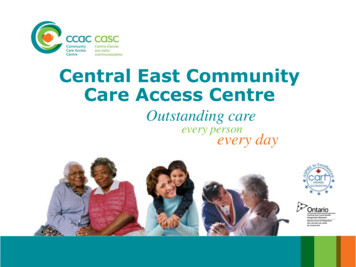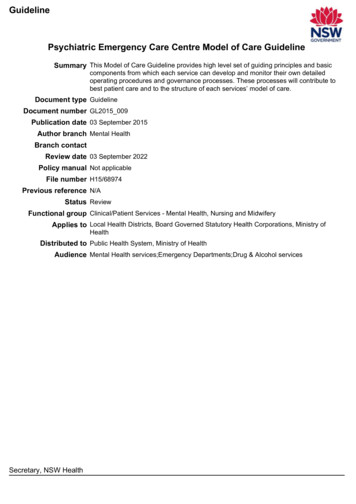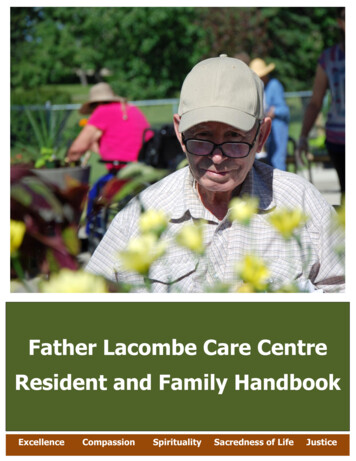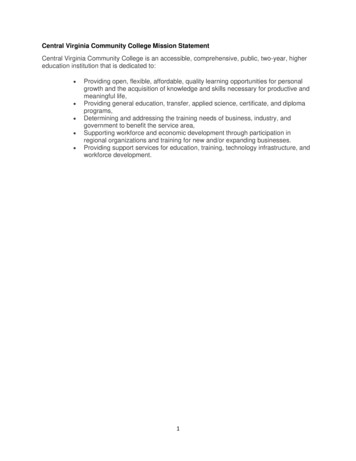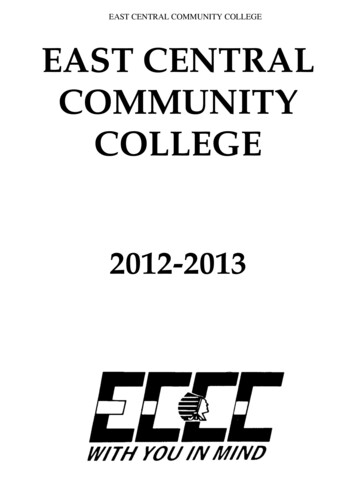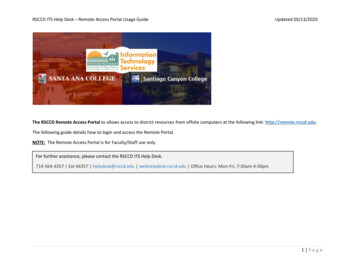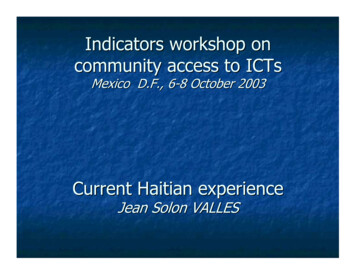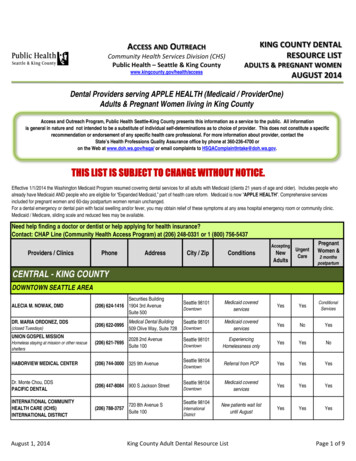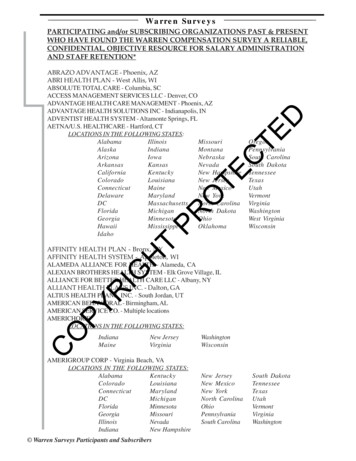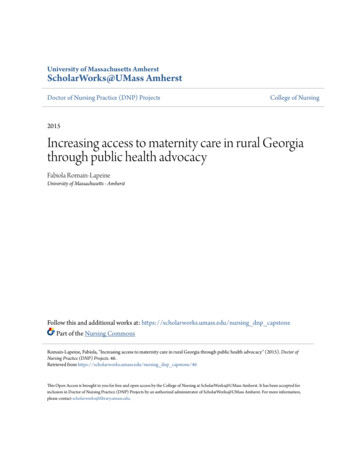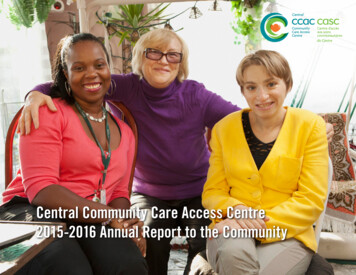
Transcription
Central Community Care Access Centre2015-2016 Annual Report to the Community
Message from the Board Chair and Chief Executive OfficerBoard of DirectorsIncreasing equitable access and improving care qualityIndividuals who served onCentral CCAC’s Board ofDirectors in 2015-2016:Along with a rapidly growing and aging population in Central region, each year, more people with increasinglycomplex needs require key health services at home and in the community. Central CCAC has responded to thechanging needs of patients and the health system by working with our care partners in new ways to deliver onour shared commitments to patients, their families and caregivers.Central CCAC’s strategic focus this past year aimed to increase equity of access and services and improve carequality for people living in the Central region. Our organization worked hard to make the best use of ourresources and reallocate savings to patient care, for example by expanding our community nursing clinics andinnovative Telehomecare program. Overall, we provided care to 86,064 patients, 4.2% more than the year before.For the second consecutive time, Central CCAC was proud to earn Accreditation with Exemplary Standing,the highest award possible from Accreditation Canada. The Accreditation process is an enabler of our visionto deliver Outstanding Care – every person, every day. It also strengthens our accountability and helpsus continuously improve safety and service quality for the more than 38,000 patients who depend onCentral CCAC each and every day.We would like acknowledge our health system partners and the Central Local Health Integration Network fortheir ongoing support. We also thank our accomplished and dedicated caring staff and Board of Directors, andour patients and caregivers for their significant contributions as we worked together to ensure people get thequality care and services they need, in their homes and in the community.Joyce BaileyEugene CawthrayJulie CordenMike DibdenJoanne FlintNoam GoodmanNevzat Gurmen1Anne KempAl LucianiJoe ParkerCaroline PintoCharles SchadeDaisy WaiDavid Y.Y. Lai 1Megan Allen-Lamb 2 (CEO)1 Completed term June 20152 Ex officioJoe ParkerBoard ChairMegan Allen-LambChief Executive OfficerCentral CCAC 2015-2016 Annual Report to the Community2
A Promise Worth KeepingNew approaches, new optionsfor palliative careCentral CCAC’s palliative support helped Ruth care for her dying husband at homeCentral CCAC, the Central LHIN and othercare partners are improving the quality ofpalliative care, and access to palliativeservices in the region, with new optionsto ensure patients and their families havethe care and support they need throughouttheir end-of-life experience:When her husband Joseph, a Holocaust survivor, was approaching the end of his life,Ruth made him a promise. “It was important to my husband to be in surroundingswhere he felt safe,” says Ruth. “I assured him I would look after him to the end. Andeven though it was not easy, he passed away in peace, here at home with his family.”Ruth looked to the Central CCAC for help in making good on her word. CCACstepped in with nursing care, guidance, information and support to ensure Joseph hadthe best possible quality of life for whatever time he had left.Joseph and RuthAnita Contatto is the Central CCAC Care Coordinator who supported the couple. She organized an inter-professional careteam around Ruth and Joseph, working with others in the local community to ensure the right supports were always in placeas his illness progressed.“My priority was to ensure Joseph’s care plan always met his needs and that Ruth, as hisprimary caregiver, was well supported through this most difficult time,” says Anita. “Thatmeant exploring every care option that might be right for them and increasing services whenneeded to help the family manage his end-of-life care at home, where he wanted to be.”In particular during Joseph’s last months, Anita worked closely with Alice Luk, a CentralCCAC Palliative Nurse Practitioner. Alice provided clinical expertise and support incollaboration with Joseph’s primary care provider, nurses, and the Temmy Latner Centre forPalliative Care.Central CCAC Palliative NursePractitioner Alice Luk and Ruth“As happens often, Joseph’s palliative experience didn’t follow a straight path,” says Alice.“A big part of my role was using my advanced knowledge and clinical judgment, thensupporting Ruth through the tough decisions so Joseph’s care and services best fit their goalsof care and what was reasonable for their changing needs.”During her many visits, Alice focused on helping the family manage Joseph’s symptoms and cope with pain, easing theiranxiety and preparing Ruth with information about what to do and who to call as her husband’s health declined and whenthe end came.Reflecting on the CCAC’s involvement, Ruth says having access to clinical advice and such compassionate care made her feelthat she wasn’t alone or struggling as she cared for her husband of almost fifty years. Helping palliative patients andfamilies manage urgent issuesaround pain, symptoms and medicalequipment, by connecting themwith a registered nurse througha 24/7 palliative care crisis line1-844-HERE4ME (1-844-437-3463). Supporting palliative patients earlierin their experience, giving theminformation about advanced careplanning, linking them to availableresources and transitioning them toCCAC services as needed, througha dedicated CCAC palliative carecoordinator. Making it easier for people to spendtheir final days in a home-likesetting with professional care, bymanaging the application, waitlist andadmission process for the region’sresidential hospice beds.For more information, please visithealthcareathome.ca/central“The superb care extended to us at this very sad time made his end-of-life passing a great comfort to me and my family, forwhich I am so very grateful,” says Ruth. “I could never have managed without the support of the CCAC.”Central CCAC 2015-2016 Annual Report to the Community3
How Central CCAC helped patients and their families in 2015-2016Increasing equitable access to quality care and services, to meet the changing needs of our patients and our communities,was Central CCAC’s top priority last year1.Supporting people in their homesand communitiesBridging the gap between hospitaland community Delivered care and services to 86,064 patients, up 4.2% Safely transitioned 39,127 patients home from hospital Supported 38,666 patients on any given day, up 6.1% Brought 1,894 hospital patients “Home First” Delivered quality, specialized nursing care to 9,200 peoplethrough our community clinics Provided short-term in-home support for 2,585 people withcomplicated health issues, through our Rapid Response Nurses Supported 10,751 children to receive care at school Supported 998 youth in schools through our Mental Health andAddictions Nurses Provided 673,055 at-school and in-home nursing visits Provided 3,680,920 hours of personal support to help peoplewith complex health issues manage their personal care Helped 3,639 people move into long-term care when they couldno longer manage at home Delivered physiotherapy to 15,231 people of all ages Placed 771 people in short-stay convalescent care so theycould recuperate and safely return homeHelping people take care of themselvesand their loved onesConnecting people to care Expanded our Telehomecare program, helping 648 patientsbecome active partners in managing their chronic illness Responded to 200,494 calls from people asking about careand services Helped 2,621 palliative patients and their families have abetter quality of living and dying Connected 3,772 patients to a primary care doctor or nursepractitioner through Health Care Connect Assisted 2,382 people to access adult day programs Logged 640,283 visits to Centralhealthline.ca from peoplesearching for health and community-based servicesclose to home Completed 1,673 assisted living/supportive housing referrals“The care we receivedthrough Central CCAChas been amazing. Wehad difficulties withmy mother’s recoveryafter surgery. Our carecoordinator helped in sucha compassionate andgenerous way. Without her,we never would have gottenthrough such a difficultand emotional situationon our own.”Casey Cookdaughter of Central CCAC patientCentral CCAC’s audited financial statements for 2015-2016 are available at healthcareathome.ca/central1Above data reflects 2015-2016 volumes and percentage increases over 2014-2015 volumes.Central CCAC 2015-2016 Annual Report to the Community4
Working with our partners to deliver innovative, integrated careAs Central CCAC continues to support more people with complex and chronic health conditions living in thecommunity, innovative programs that bring together care partners from across the health system are becoming evenmore important to increase equitable access to quality care.Community nursing clinicsTelehomecareCentral CCAC is helping patients avoid the emergencydepartment and return home from hospital faster withhigh quality, specialized nursing care at one of ourseven community nursing clinics. For people who donot need in-home care, and who are eager to get back totheir normal home and work routines, our clinics are anexcellent option for treatments such as IV antibiotics orwound care. With the support of our hospital partners,in the past year we added more treatment space at severalclinic locations and extended operating hours at others, toprovide even more patients with access to care. Clinics arealso cost-effective, which helps CCAC deliver care to morepeople.Improved quality of life and fewer emergency departmentvisits and hospital admissions are the key benefits forpatients, of Central CCAC’s innovative Telehomecareservice. Using simple home-based technology – and remotemonitoring and health coaching from a Central CCACnurse – patients with obstructive pulmonary disease andcongestive heart failure learn to monitor their vital signsand identify new or changing symptoms. Our nurses alsowork with patients and their primary care providers to sethealthy living goals. Last year we worked with the OntarioTelemedicine Network to expand Telehomecare in ourregion, helping even more patients become active partnersin managing their chronic illnesses.Assess and RestoreIntegrated care modelsMore seniors are regaining and maintaining their mobilityand functional independence, so they can leave hospitaland remain in the community longer, thanks to anexpansion of the Assess and Restore initiative in Centralregion this past year. This collaborative model of careprovides early and continuous rehabilitation-focusedintervention to frail seniors in the community, who areat risk of hospitalization or long-term care placement. Apartnership with North York General Hospital, Assess andRestore has demonstrated exciting early results, includingimprovements in several key measurements of health.Making sure patients are supported with timely access to thecare and services needed for a safe and successful transitionfrom hospital to various community care settings, is theaim of a new integrated care model. Along with hospital,primary care and community partners, Central CCAC isa key contributor to two of six recently launched Ministryof Health and Long-Term Care-funded pilot projects inOntario. One is a stroke care initiative led by SunnybrookHealth Sciences Centre. The other is for patients withchronic obstructive pulmonary disease and congestive heartfailure, led by North York General Hospital. By workingtogether, care providers educate patients and their caregivers– helping them better understand how to manage theirhealth and remain more independent.Central CCAC 2015-2016 Annual Report to the CommunityStay connected with us1 888 470 2222TTY 416 222 0876310 2222(no area code required) healthcareathome.ca/centralcentralhealthline.ca5
Central CCAC 2015-2016 Annual Report to the Community Supporting people in their homes and communities Delivered care and services to 86,064 patients, up 4.2% Supported 38,666 patients on any given day, up 6.1% Delivered quality, specialized nursing care to 9,200 people through our community clinics
